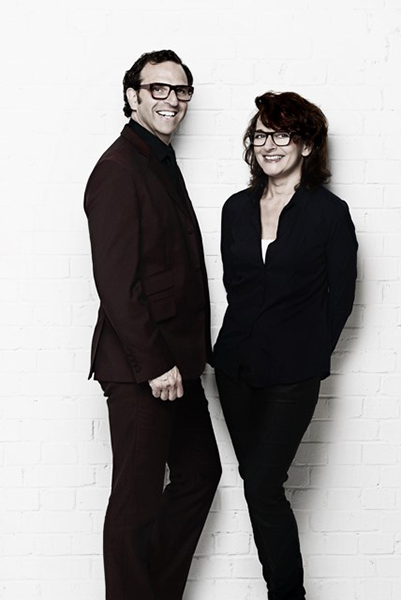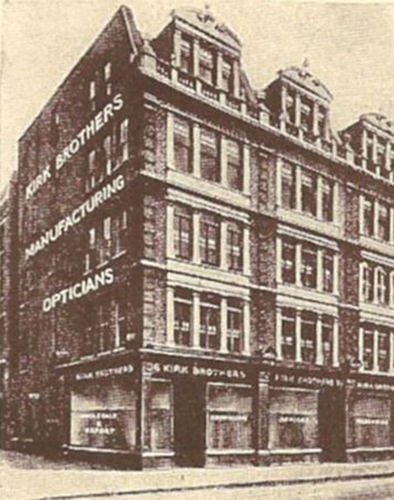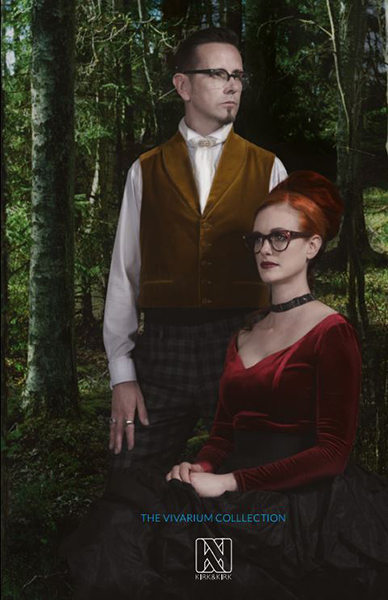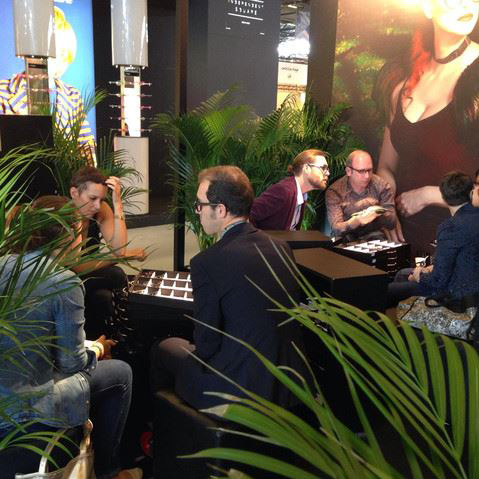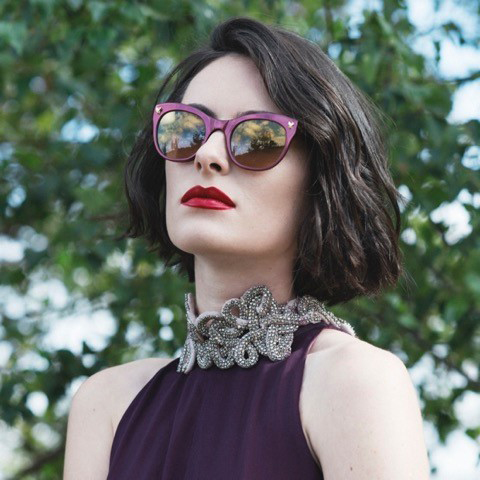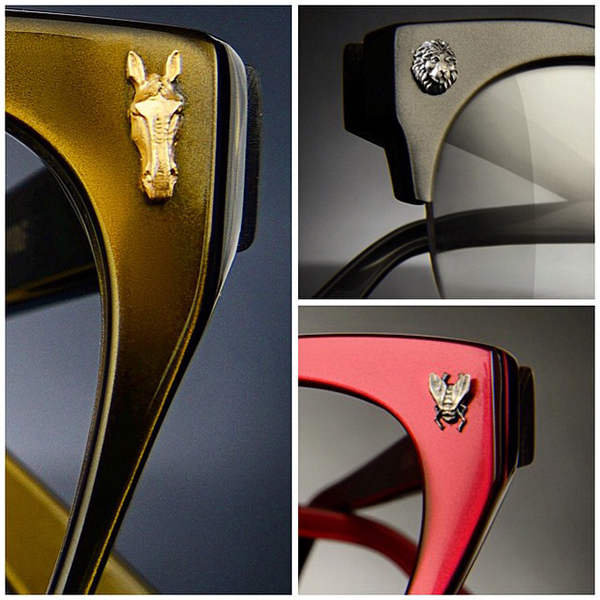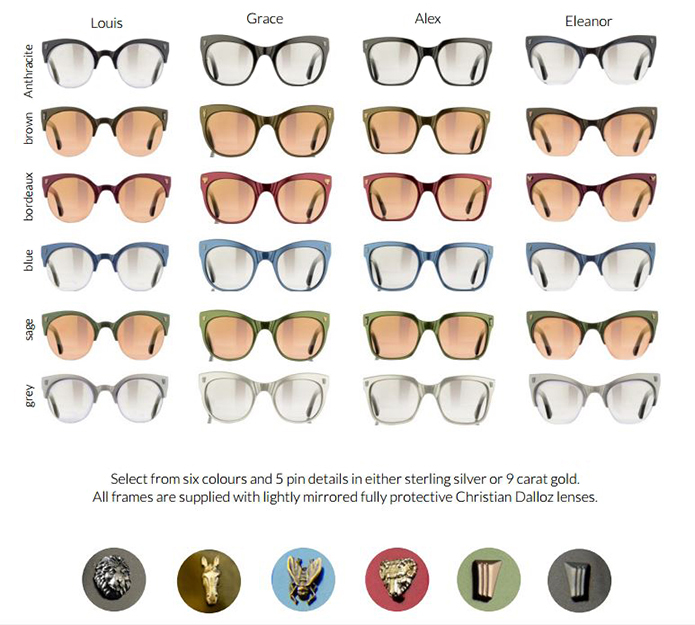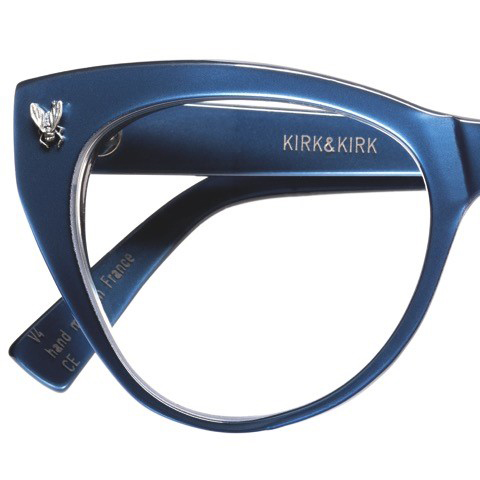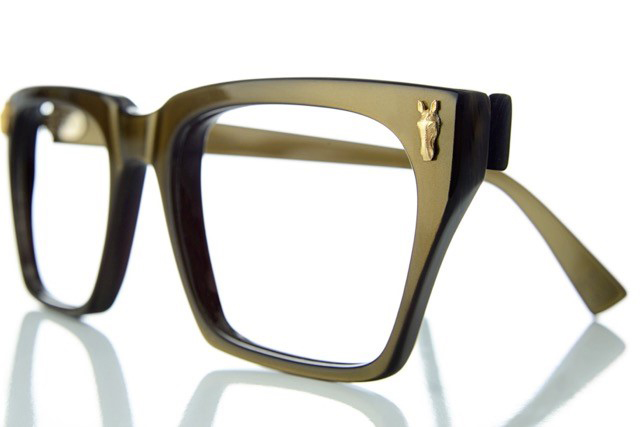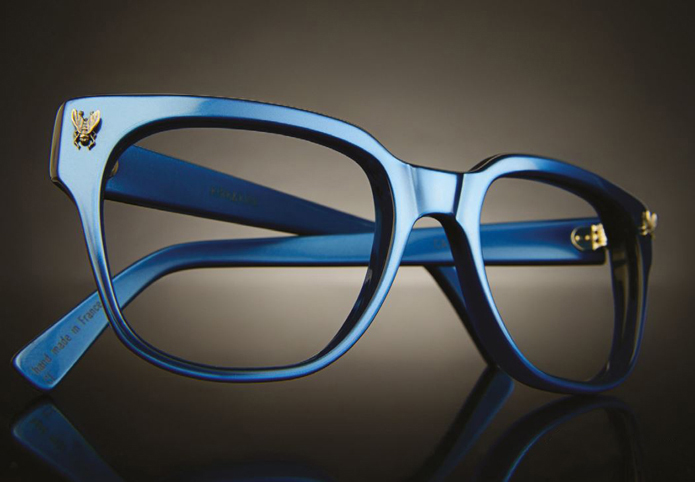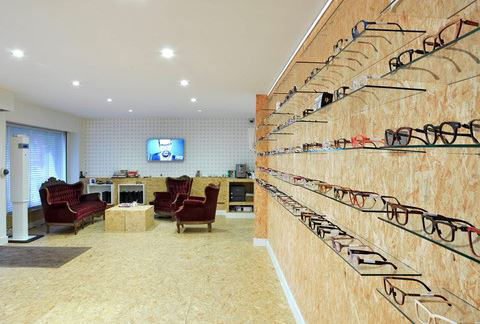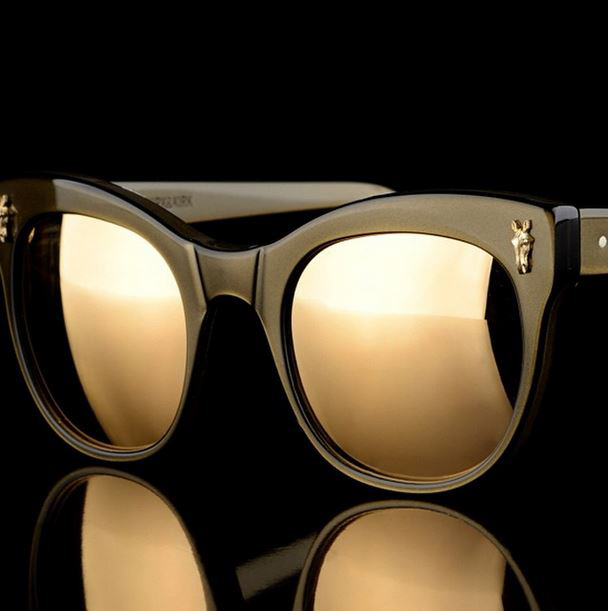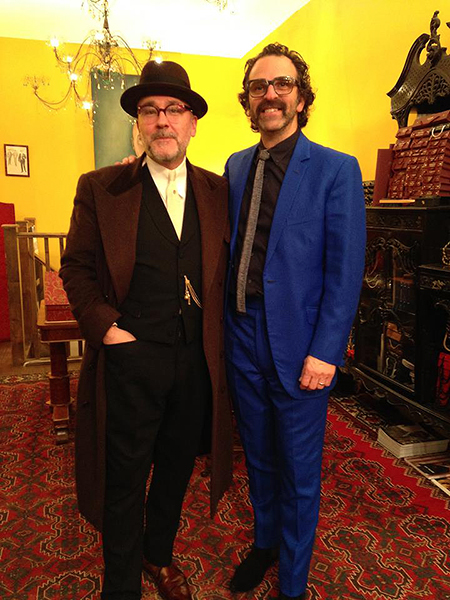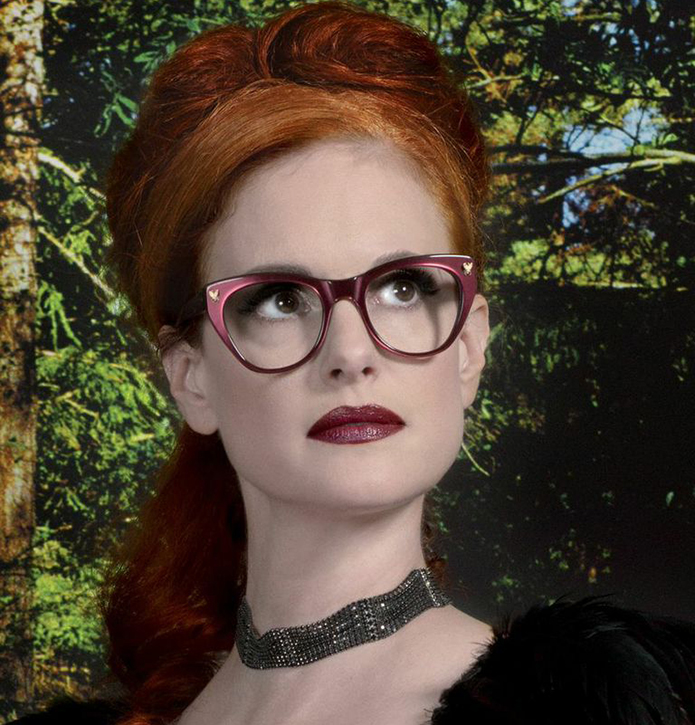
If eyes are the windows of the soul, glasses should window-dress them perfectly… and this definitely echoes the ethos of Kirk & Kirk, who believe that a pair of glasses should be above and beyond a medical device or fashion item, but an aesthetic reflection of the personality of the wearer behind the exquisitely handcrafted apparatus so familiar to us all.
Husband and wife team Jason and Karen Kirk are Kirk & Kirk, third-generation (on Jason’s side) eyewear designers and makers that have retained an artisanal approach to manufacturing glasses, and yet remained at the cutting edge of optical design. Their signature styles, collaborations and bespoke commissions all begin with French handcrafted frame-making, working with versatile Italian acrylic and conclude with jewellery finishes handmade in England, resulting in solid-looking, colourful, individual frames which are light, flexible and comfortable to wear, and in Jason’s words ‘should make you feel great’.
A pair of Kirk & Kirk glasses is truly the result of Continental team-effort in an otherwise sea of mass-production, and this can be felt when you handle the finished glasses, using materials and craftsmen from areas renowned for their expertise, resulting in the perfect combination of practicality and purpose, style and soul.
We hope, through this interview with Jason Kirk, you gain an appreciation and insight into the world of luxury handcrafted eyewear…
Firstly, for those readers who aren’t familiar with Kirk & Kirk, please can you tell us what you do?
We design eyewear, both glasses and sunglasses, for ourselves and other companies. Our designs are unique and different to anything else that is out there.
This is a recent venture for you, what prompted you to launch Kirk & Kirk?
My grandfather was the founder of modern optical manufacturing in the UK. He and his brother set up a company called Kirk Brothers, and as designers and manufacturers they helped make London a centre of optical excellence throughout the 1920s and 30s.
My father also practised as an optician, and whilst I’m the third generation in my family to enter the industry, I didn’t do this straight away – it wasn’t until 1992, when I was clearing out my father’s old practice, that I found a box containing two hundred beautiful frames that my grandfather had created dating from the 1950s and 60s. They inspired me to such an extent that I when I was made redundant from L’Oreal that same year, I used my severance package to make copies of my grandfather’s glasses which I then sold to famous designers, such as Helen Storey.
Around this time, I met my wife, Karen, who was a graphic designer, and together we started designing our own glasses. These were entirely new designs, rather than copies, using modern acetates (an organic plastic used for making eyewear) rather than metal, however we still took inspiration from my father and grandfathers’ heritage, and the manufacturing of these new frames was still very artisanal. This was the start of our first business – Kirk Originals. We built up the business over the following twenty years, opening three shops in London, but we reached the point where to achieve its full potential we needed external investment. Unfortunately we didn’t share the same vision as the investors, and we left in 2013.
Before deciding on our plans following our exit we needed time to reflect and review what we wanted to do. We put a message out on social media that we would be visiting the leading international eyewear trade show, Silmo, in Paris in an informal capacity, and we received so much industry support at the event that we decided there and then to launch Kirk & Kirk.
We had a refreshing period of eighteen months not working to any deadlines, which gave us time to design without being under pressure to be ready for a launch date. It also allowed us to bring out completely new concepts and designs. We launched our first collection, Vivarium, in October 2014 in Paris, and were delighted that so many top opticians and stores decided to support us.
The biggest difference with Kirk & Kirk is that Karen Kirk is right at the fore of the business as our Creative Director, whereas at Kirk Originals Karen was more in the background.
What was the source of inspiration for your debut collections, Solarium and Vivarium, and can you explain their design?
The inspiration for our Vivarium collection is Victoriana and Victorian decorative arts. This was a period where lots of animals were used in art and design, such as within jewellery, umbrella handles, door knobs, and the like, and this is a concept we wanted to explore within our designs as we find the style really beautiful. The inspiration for our Solarium collection is similar, exploring the Victorian obsession with science and nature.
We want to make our glasses feel like they’re alive, and are a friend to the wearer, rather than purely a medical device or a fashion item. We want to bring out a personality and introduce an element of humour in there as well. It’s quite difficult when introducing a new design to strike the balance between what we find fascinating and what our consumers will be receptive to. Sometimes designers can get a bit too self indulgent and the things we enjoy may be too much for consumers, so we give a nod to our inspiration, rather than going too far. We incorporate a decorative pin within our glasses in the form of a small animal, but it’s not too large or garish, and will only be recognisable by the people you are directly engaged in speaking with.
We’re one of the few companies that use acrylic frames, as most designers use acetate these days. We have developed a special grade of acrylic with an Italian manufacturer that has unique properties which allows us to create frames that appear substantial and chunky, but are in fact incredibly light. It’s also possible to create a much wider range of colours and finishes using acrylic which you just don’t get with acetate, which is why our collection has such a distinctive colour palette. The skilled artisans who make the frames in France have all had to adapt their skills over a period of two or three years to work with this material. The animal jewellery in both silver and gold is hand made in Birmingham, England, rather than mass-produced, which we feel gives the glasses a ‘third dimension’.
What was the reason for basing production in France, and how do you ensure the quality of what is produced, given that it is all handmade?
I’ve been making frames for fifteen years, both in England and France, and I honestly feel that in France it’s such an artisanal industry and the workers possess the perfect combination of skill, experience and passion – they are true craftsmen. So we choose to use artisans in France, rather than anywhere else, because in our opinion it’s the best place to make our type of glasses, and they produce the highest grade product. Equally, the jewellery that adorns our glasses is made in England, as that’s where the best jewellery makers are found.
We lived in Bordeaux for ten years, and speak fluent French, so that certainly helps with communication. What I look for in a factory is artisans that are passionate about their art but open to exploring new ways of doing things, even if they haven’t tried them before. You don’t really find that in industrial production as it’s just not cost effective for the large factories.
I’ve got to know who are the most appropriate artisans for a particular project, and can hand pick the team based on what I’m looking for. I regularly visit the workshops to ensure quality, however it really makes a difference when the artisans really care about the product, and you know they won’t accept anything less than “beautiful”. When you hold a pair of finished glasses made by hand you can really appreciate the quality – it’s not about the weight, as they’re actually quite light, but it’s just a feeling you get from holding them, which is quite intangible and can’t easily be explained.
By way of an insight into the artisanal production of your eyewear, could you briefly describe a brief history behind glasses-making and the process of crafting a pair?
The history of glasses-making goes back a long time. In the UK, the famous glasses-making areas were established in London, as this is where the early Huguenot and Jewish families settled with their craft trades, but there were also areas of glasses-making in traditional steel producing areas which led to a range of associate cottage industry trades, so areas like Sheffield, Wolverhampton and South Wales became associated with the trade as well.
In France, the department of Jura in the Franche-Comté region on the Swiss border, in the east of the country, became famous for glasses-making. In previous centuries, farmers in the area took to making items in the cold winters to find additional ways to be productive; at first they started making combs, but when that trade succumbed to mass-production and they couldn’t compete, they went into glasses-making instead, which was around the late 19th Century. They followed in the footsteps of the Huguenots who brought with them watch-making skills from Switzerland, which were skills that could be applied to making glasses as well. These were small-scale cottage industries where people would work together – one person would make the sides, another the fronts, and another the pins. The area is still famous for glasses production, and whilst there’s a mix of large scale producers now, there are still lots of small-scale artisanal producers remaining.
The key aspect with our glasses is that they’re all handcrafted by artisans, rather than cast or injection moulded. The majority of glasses are injection moulded acetate these days, especially the inexpensive ones, but for us it’s about handcrafting glasses from sheets of acrylic. We start by cutting the inside of the acrylic sheet first, then the outside. Someone else will cut the sides. Joints are pinned by hand to frames. We have to ensure the butt end, where the front and sides meet, is fitted incredibly precisely to ensure the two parts line up together in a flush manner, which is an incredibly precise art. Once the parts of the glasses are fixed, the frames are ready for polishing, whereby they are put in a barrel with wood chip and pumice. The aggregate will change the finish of the glasses – where rough and matt or sharp and shiny – depending on the length of time in the barrel and the exact mixture used. This is a very skilful process which might take several days. The glasses are then given a further polishing by hand afterwards.
The entire process, from start to finish, is very skilful, and it really does demonstrate the difference between industrial production versus an artisanal approach by craftsmen who are passionate about their art.
It’s sad, but there’s a lot of dishonesty in the eyewear industry today in the way the products are being marketed and presented to consumers with regards to provenance. In many cases glasses are only designed in Europe and are made elsewhere but they are still marked “Made In France’. Personally, I feel they lack integrity and it’s so important that there is full transparency in where and how eyewear is made to allow consumers to understand the value of a product and make an informed choice.
How important is the choice and quality of raw materials in creating glasses?
It’s incredibly important. We’re not the only industry that’s affected by this, but certainly eyewear makers have fewer and fewer suppliers, and it’s becoming harder to find the quality of materials that we require. We use acrylics, but for those eyewear producers that use acetate, the UK producer Rhodoid has gone, and two remaining European producers, Mazzucchelli and Laes from Italy, have moved most of their production to the Far East.
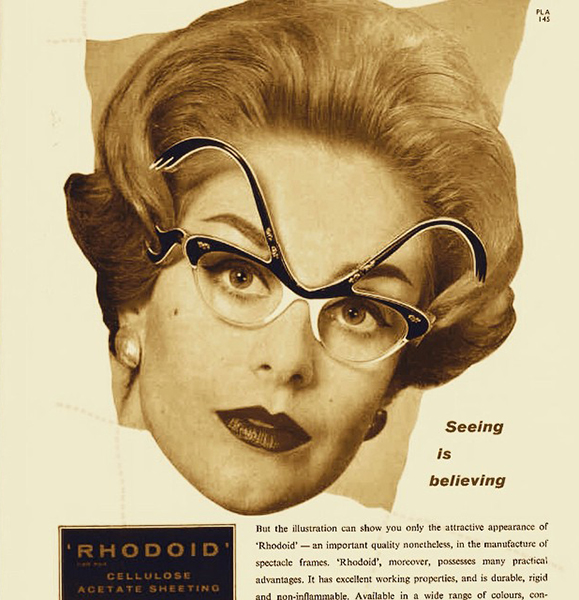
‘Seeing is believing’ from when acetate was being produced in England. Vintage advertisement for Rhodoid acetate.
With creative acetates, there’s a difference between factories in terms of quality levels for utilitarian and creative purposes, and if you don’t have the right quality materials, the end product will be poor. With glasses made from acetate, the glasses are susceptible to distortion if the joint, or reinforcing wire, that connects the front to the sides is damaged, for instance if the pin gives. For example, poor quality acetate might simply bend back to its original shape as it never loses its memory, which is a problem.
We make our glasses from acrylic instead of acetate; acrylic is a noble material and easier to manipulate than acetate. It will maintain its shape, so that once the frames have been adjusted by the optician, they won’t need further adjusting, which is often the case with acetate glasses. Large scale producers of our raw material do struggle to produce small quantities for small creative producers, making it unviable for many designers to create short runs of exciting materials, but we are lucky.
Are you solely focussed on the domestic market, or is it your intention to market your glasses internationally?
We are totally international and attend a variety of international trade shows. We’re very lucky in that already we’re working with a number of the best opticians and select boutiques around the world. It’s important that we work with retailers, irrespective of country, that know how to communicate our products and share the passion for our eyewear, and aren’t just content to put the collection on a shelf. We need consumers to feel and touch the glasses, and for our retailers to communicate the message of how they’re made, the design and the elements that make them so special, so that customers can share feelings for our products long after they’ve gone out into the world. Such appreciation isn’t limited to specific geographic markets.
With a truly international customer-base, are there different types and styles of eyewear favoured in different countries?
There are certainly practical elements, such as different fittings for slightly different face types around the world. Some countries will take up designs sooner and embrace styles earlier than others though, but overall, in terms of patterns, there’s a certain uniformity around the world, influenced by the internet; for example, people are really into large, over-sized glasses with a thickness in the frame at the moment.
Customers are spoilt for choice today with a vast array of glasses on offer, can you give any tips for someone choosing eyewear for the first time?
Simply, you should feel two inches taller when you put the glasses on. The feeling of wearing something special should make you feel great. There are lots of technical tips, such as having the sides and fronts aligned, but I would advise going to an independent opticians for a professional view. Choosing the right pair of glasses is partly a medical consideration, but the aesthetic value is really important and it should reflect your personality. I have several pairs of glasses and I may change them during the day depending on mood or what I’m doing, such as for reading in the comfort of my home or during a business meeting. There is some beautiful eyewear from certain independent designers that will make you feel fantastic, and that’s what you should aim for.
Glasses have certainly become more of a fashion accessory in recent years, rather than purely worn out of necessity. Why do you think this trend occurred and what do you think wearing glasses says about a person?
If you look at the history of British optical manufacturing, it was only really in the 1920s and 30s that glasses were being sold as shapes and finishes, based on how they looked rather than what you saw through them. This was an era when for the first time people could access international film stars, such as Harold Lloyd, where glasses became part of their persona and certainly influenced buying habits. Many glasses at this time were made from real tortoise shell. During the Second World War, however, the only glasses available in Britain were those that were army surplus little round metal glasses, and even following the war, when demand for glasses was immense with the commencement of free glasses on the NHS in 1948, they were still made from acetate in only a handful of designs. People yearned for individuality again, and some people started importing distinctive designs from Scandinavia, France and Spain, but by the 1950s, British manufacturers started developing new styles again. If you look at Pathé newsreels from the era, you can see people wearing beautiful glasses in the 1950s, which, again, influenced buying habits.
In different eras and decades, the relationship changes between the customers and the eyewear manufacturers. In the 1980s, ‘brand’ became important, and Giorgio Armani was one of the first to influence this. Then dedicated eyewear ‘designers’ got involved, and brand name was deemed less important than the creativity aspect, and designers such as Alain Mikli were very influential at the time.
As to what I think wearing glasses says about a person, I think glasses should always express your personality. People often say you can tell a person by their shoes, well it’s the same with glasses. If you wear bright red glasses, for example, you are making a statement that you’re obviously not shy. I personally like to wear exuberant, colourful eyewear, as it suits my personality, but sometimes maybe I don’t want to stand out from the crowd, and I’ll wear something slightly more sedate. People will always make a judgement on a person based on the glasses they wear. Everyone is interesting. Everyone has something to say. Say it through glasses.
Aside from your two Kirk & Kirk collections, do you also create bespoke designs and special commissions for individuals or other companies?
Yes, we work for both individuals and other companies. As designers, our role is to respond to a brief, and whilst we design our own eyewear, we will work on collections for other companies that want our fingerprint on the design; we are working on three such collections at the moment.
We’ve also carry out special commissions for individuals. We have designed bespoke eyewear for the likes of Stevie Wonder, Adam Clayton, Dave Stewart, Gary Oldman and Robbie Williams in the past. In my experience, it’s the really creative people that tend to want to commission a pair of bespoke glasses, whether that’s in music or film. It’s really important to chat with them and listen to what they have to say, in terms of what they enjoy and how they want to communicate their passion. It’s relatively easy to creative the glasses shape, but it’s matching the style – in terms of finish and colour, for instance – to fit the personality, that’s where the experience comes in; the art of translating someone’s DNA into a pair of glasses.
Finally, what’s next for Kirk & Kirk; are we going to see one-off collaborations with other designers, opening of a physical store, greater eyewear ranges?
We’re unashamedly ambitious, but whilst Karen and I have been in the industry for some time, it’s still early stages for Kirk & Kirk as a business, and we need to establish our foundations first. Personally, I love retail, but retail is changing so quickly, and it’s difficult to know month-on-month what consumers want. Maybe that’s an option at some point…
I’d really like to collaborate with others – both fashion and eyewear collaborations. We’ve been working on a range with the bespoke tailor – Mark Powell – which is coming out this autumn. We love his style, which is individual, classic, and ever so slightly anarchic and idiosyncratic, and we’re passionate about his work. I can certainly imagine further fashion collaborations such as this.
We’re really open to new ideas and approaches, particularly unexpected creative collaborations, which are great fun, especially those that are completely abstract, which helps us maintain our principles to always do something different.
There’s a slight dichotomy in the brand that we want to create for Kirk & Kirk; we don’t want people to buy our glasses out of loyalty to our brand name, we want people to come back and buy our glasses because they know we will continue to better ourselves, which in a sense will build brand loyalty as a result.
Thanks to Jason Kirk for taking time out of his busy schedule to answer our questions. All images courtesy of Kirk & Kirk.

